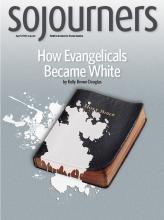THE WHOLE CHRISTIAN YEAR stretches toward this moment when we reach back to acclaim the power of God over death manifest in the resurrected life of Jesus. The passion and pageantry of the days from Palm Sunday to Easter Sunday enable believers to mystically live in the ancient moments we commemorate. At the same time, we are very much present in a world that is anything but resurrected; it is, as I often preach, “crucified and crucifying.” It is easy to find the broken places in our world and those that deal death. Where are the resurrection spaces? Where do we look to see that death does not, in fact, have the last word? What is our work in bridging the gap between death and life?
This month’s lessons brim with passionate faith on Jesus and his triumph over the grave. These accounts stem from nearly a century and more past the events that inspire their faith. The authors and editors of these texts also lived in a world in which the triumph of the resurrection was not apparent in many aspects of their lives; many went to gruesome deaths confident in the resurrection despite the power the empire wielded over their mortal lives. To strengthen our faith, they left us the accounts in the scriptures we read in this season. But we are not dependent on their words. We have unmediated access to the love and power of the resurrected Jesus.
Read the Full Article

